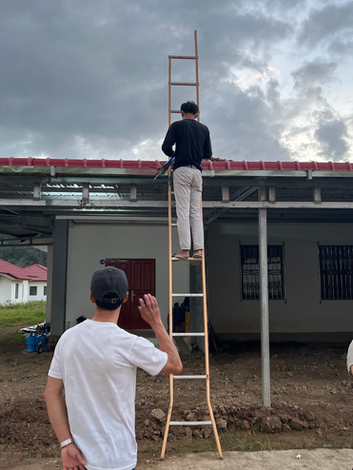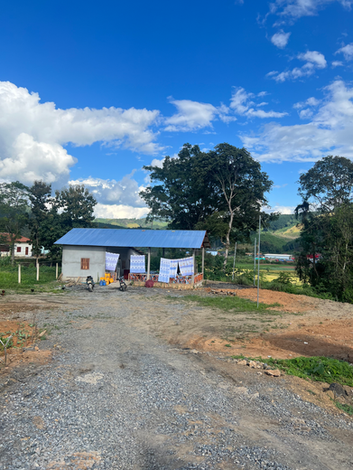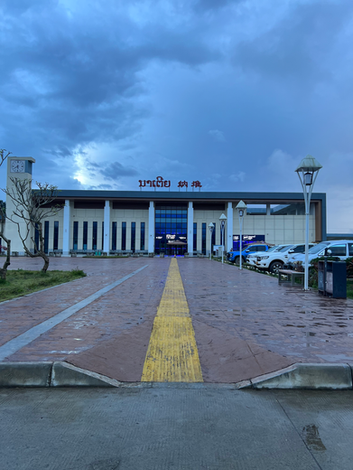Na Taey Junction: The transformation of the community into
Future industrial city

“Namtha Bo, Muang Sing, taxi, van Bo,” the call of drivers who are calling for passengers who want to travel to their destinations. This is the chaotic atmosphere just a few tens of minutes after we walked out of Nateuy Station. Nateuy Railway Station is the station before Boten border station and is the city where most passengers get off to travel to nearby cities such as Muang Sing, Namtha, Muang Ton Pheung, and the Golden Triangle. The time when the station has a lot of cars waiting to pick up and drop off passengers is only from around eleven in the morning to three in the afternoon. Last time, we presented the context of Nateuy and the impacts in many forms: expropriation, relocation, and the need to change the way of life of the people in the area through Chailai in Laos (2). Nateuy episode (see https://www.chinaseasia.net/storiesoflaos2) This time will present the changes in the six months since the first field visit in May 2023 and this time in October 2023.

After getting off the station, we chose to walk to the Na Tae community to stay at the Chinese hotel we stayed at last time. Around the station, we found some changes. We found that there were two new restaurants. The first restaurant was next to the inner fence of the station, while the other was outside but not far from the station. On our way out of the station, we chose to walk through the community because we didn’t know if there were any short-distance shuttles (almost 2 kilometers). Most of the time, there were only long-distance shuttles or taxis for long distances, such as 60,000 kip per person for a van, 100,000 kip per person for a sedan that can accommodate five people, and 500,000 kip for a private car to Luang Namtha. On our way there, we got lost and passed by people’s houses. Children were playing in front of their houses. As outsiders, we looked at the people here and their houses with excitement, but we didn’t feel any strange or suspicious looks from the people in the community. We felt that everyone seemed familiar with strangers walking around their houses. It was only us who were not familiar with the place and the people here.
Within the community, we noticed that new restaurants were opening, old ones were still there, and the central road was still dominated by Chinese immigrants who came to do business more than ten years ago, including restaurants, grocery stores, hardware stores, and in the market itself, there were Chinese people who opened shops mixed in with Lao people. The area near the station was mostly old farmers of various ethnic groups, while in the middle of the community were new farmers who had immigrated. The further away area was a new road to Boten. From walking around and trying out the community for a short period of time and trying out various restaurants, we noticed that there were more and more new restaurants opened, both owned by Lao and Chinese people, such as a Mala barbecue restaurant, Jindad restaurant, Fujian Chinese restaurant, Pho restaurant and a la carte restaurant, etc.

If we go out along the new road, outside the village in the residential area, we find an empty area that has become a garbage dump, and nearby there are trees cut down to create a wide area. The people there told us that this area is where the Amata City Na Toei project will be, by Amata Corporation, which has signed a concession with the Lao PDR. According to the project's policy, it focuses on creating a modern city that is friendly to the environment. This land was originally a rubber plantation (the surrounding area is still there) and the land was purchased from many villagers, combined into a large plot through a Lao middleman who contacted the area. As for the area where the project will start, it is a wide area. The topsoil is black because the soil is grade 3 coal, which is low-quality coal. The project has a community meeting that will allow the children of the people who sold the land to work in the factory as a special case. The first factory in the future will likely be a rubber plantation - according to Ai Saeng, the informant.

According to the information on the website www.amata.com, the project will start in 2022. The importance will be the strategic location of the project, which is adjacent to the Nateuy Railway Station, which is convenient for traveling to the China-Laos Railway Station and connecting to neighboring countries such as China, Thailand, and related infrastructure. It also presents the area under Luang Namtha Province, “a 140-kilometer land border with the People's Republic of China and a northwestern border with Myanmar, a 130-kilometer border stretching along the Mekong River and Oudomxay Province of Laos, with Luang Namtha as the capital city” (https://www.amata.com/th/our-location/laos). Due to the location with many important infrastructures surrounding Nateuy, it is an important part that can attract more investors. It is also an important opportunity for the Nateuy community, which still has to wait and see in what direction this construction project will create changes in the Nateuy Junction community.

Image source: https://www.amata.com/our-location/laos/nateuy
Not far from the Amata City project is a housing estate of those who were expropriated for the railway construction project. In the evening, we went to explore the community again. At present, there are more residents than before, about 20 households. Now there are 50 more households, making the village look more lively than before. Many houses have been extended and are bigger, making them look more spacious and grand. Some houses have air conditioners installed. Many houses have small gardens around the house. Some houses that have been extended are intended to be shops selling things and drinks. Many houses have changed hands, both for sale and for rent. However, the informants said that one reason why some people don't like housing estates and don't want to move in is because they are close to the community's new cemetery.
The original cemetery was the area of the railway station. Before the construction, a shaman was invited to perform a ceremony and the cemetery was moved to another location. The new cemetery is located near the housing estate. Even Ai Saeng (the informant) thought that he would watch his son's attitude and what he would do with his son who is now studying Chinese. He might sell the house that he has received, which is rented out, or keep it as his son's inheritance. Or he might rent it out to workers when the Amata factory is finished.
Further observations from this visit, we found that the people of Natay are trying to find opportunities and possibilities to continue living amidst the changing environment and society. Civilization and infrastructure have clearly changed their way of life and also motivate these residents to anticipate problems or opportunities according to their own way and conditions in order to cope with the developments that will occur in the community.
* This work is part of the research information dissemination activity to the public under the project "Cross-border China Railway: A comparative study of the impact of railway construction projects on communities around main stations in Thailand and Laos", funded by the Office of the Higher Education, Science, Research and Innovation Policy Council (NSTDA) by the Human Resource Development and Institutional Development Fund Management Unit (NHRC) for fiscal years 2021 - 2023.
** The research project is currently underway. The published content is part of the data collection and is not a conclusion of the research results.

Panitda Saiyod
หัวหน้าโครงการ

Playfa Namphrai
Research Assistant

Kesone Kanhalikham
Research Assistant











